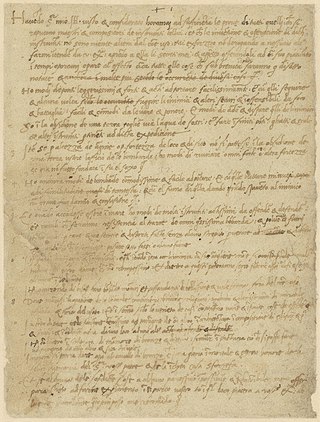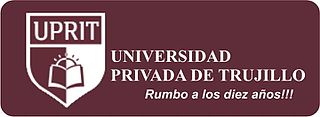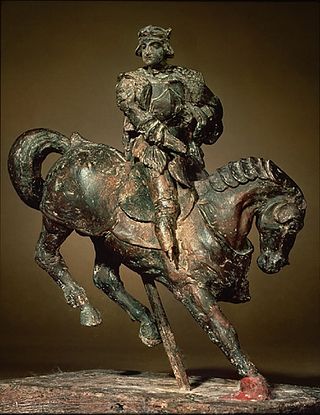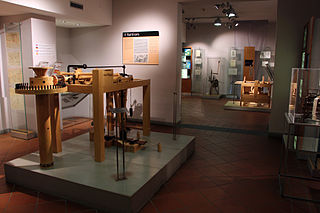Related Research Articles

Leonardo di ser Piero da Vinci was an Italian polymath of the High Renaissance who was active as a painter, draughtsman, engineer, scientist, theorist, sculptor, and architect. While his fame initially rested on his achievements as a painter, he also became known for his notebooks, in which he made drawings and notes on a variety of subjects, including anatomy, astronomy, botany, cartography, painting, and paleontology. Leonardo is widely regarded to have been a genius who epitomized the Renaissance humanist ideal, and his collective works comprise a contribution to later generations of artists matched only by that of his younger contemporary, Michelangelo.

The Mona Lisa is a half-length portrait painting by Italian artist Leonardo da Vinci.

The Vitruvian Man is a drawing by the Italian Renaissance artist and scientist Leonardo da Vinci, dated to c. 1490. Inspired by the writings by the ancient Roman architect Vitruvius, the drawing depicts a nude man in two superimposed positions with his arms and legs apart and inscribed in both a circle and square. Described by the art historian Carmen C. Bambach as "justly ranked among the all-time iconic images of Western civilization," the work is a unique synthesis of artistic and scientific ideals and often considered an archetypal representation of the High Renaissance.

Trujillo is a city in coastal northwestern Peru and the capital of the Department of La Libertad. It is the third most populous city and center of the third most populous metropolitan area of Peru. It is located on the banks of the Moche River, near its mouth at the Pacific Ocean, in the Moche Valley. This was a site of the great prehistoric Moche and Chimu cultures before the Inca conquest and subsequent expansion.

The Queen's Gallery is the main public art gallery of Buckingham Palace, home of the British monarch, in London. It exhibits works of art from the Royal Collection on a rotating basis. It has its own access façade and typically displays about 450 works, always including mainly paintings and drawings.

Walter Seff Isaacson is an American author, journalist, and professor. He has been the President and CEO of the Aspen Institute, a nonpartisan policy studies organization based in Washington, D.C., the chair and CEO of CNN, and the editor of Time.

Leonardo da Vinci was an Italian Renaissance painter and polymath who achieved legendary fame and iconic status within his own lifetime. His renown primarily rests upon his brilliant achievements as a painter, the Mona Lisa and The Last Supper, being two of the most famous artworks ever created, but also upon his diverse skills as a scientist and inventor. He became so highly valued during his lifetime that the King of France bore him home like a trophy of war, supported him in his old age and, according to legend, cradled his head as he died.

Martin John Kemp is a British art historian and exhibition curator who is one of the world's leading authorities on the life and works of Leonardo da Vinci. The author of many books on Leonardo, Kemp has also written about visualisation in art and science, particularly anatomy, natural sciences and optics. Instrumental in the controversial authentication of Salvator Mundi to Leonardo, Kemp has been vocal on attributions to Leonardo, including support of La Bella Principessa and opposition of the Isleworth Mona Lisa.

The Italian polymath Leonardo da Vinci (1452–1519) left thousands of pages of writings and drawings, but rarely made any references to his personal life. The resulting uncertainty, combined with mythologized anecdotes from his lifetime, has resulted in much speculation and interest in Leonardo's personal life. Particularly, his personal relationships, philosophy, religion, vegetarianism, left-handedness and appearance.

Codex on the Flight of Birds is a relatively short codex from c. 1505 by Leonardo da Vinci. It comprises 18 folios and measures 21 × 15 centimetres. Now held at the Royal Library of Turin, the codex begins with an examination of the flight behavior of birds and proposes mechanisms for flight by machines. Leonardo constructed a number of these machines, and attempted to launch them from a hill near Florence. However, his efforts failed.

Leonardo da Vinci was a Marconi-class submarine of the Italian navy during World War II. It operated in the Atlantic from September 1940 until its loss in May 1943, and became the top scoring non-German submarine of the entire war.

The Lucan portrait of Leonardo da Vinci is a late 15th- or early 16th-century portrait of a man that was discovered in 2008 in a cupboard of a private house in Italy. It strongly resembles a portrait of Leonardo da Vinci by Cristofano dell'Altissimo held by the Uffizi Gallery. The painting was previously thought by its owners to represent Galileo but on its discovery a claim was made that it is a self-portrait by Leonardo da Vinci. Alessandro Vezzosi, director of the Museo Ideale Leonardo da Vinci at Vinci said in 2011 that he had excluded the possibility that it was a self-portrait, but that the painting "remains intriguing because it adds a new element to the Leonardo puzzle".

La Scapigliata is an unfinished painting generally attributed to the Italian High Renaissance artist Leonardo da Vinci, and dated c. 1506–1508. Painted in oil, umber, and white lead pigments on a small poplar wood panel, its attribution remains controversial, with several experts attributing the work to a pupil of Leonardo. The painting has been admired for its captivating beauty, mysterious demeanor, and mastery of sfumato.

Salvator Mundi is a painting attributed in whole or in part to the Italian High Renaissance artist Leonardo da Vinci, dated to c. 1499–1510. Long thought to be a copy of a lost original veiled with overpainting, it was rediscovered, restored, and included in a major exhibition of Leonardo's work at the National Gallery, London, in 2011–2012. Christie's claimed just after selling the work that most leading scholars consider it to be an original work by Leonardo, but this attribution has been disputed by other leading specialists, some of whom propose that he only contributed certain elements; and others who believe that the extensive damage prevents a definitive attribution.
Catholic University of Trujillo is a Peruvian private university located in Trujillo, Peru. It was born as an initiative of the Archdiocese of Trujillo on December 12, 1999, being Archbishop of Trujillo Héctor Miguel Cabrejos Vidarte, and taking as the first President of the Commission of Government the person of Jose Maria Garcia Madariaga. The operation of the university was authorized by resolution UCT 147-2000-CONAFU on November 13, 2000, and academic activities began on January 2, 2001.

The Private University of Trujillo (UPTP) is a Peruvian private university founded on October 11, 2006, in the city of Trujillo, La Libertad Region.

Horse and Rider is a beeswax sculpture depicting a rider on a horse. The history of the sculpture is unknown before the 20th century. The work has been attributed to Leonardo da Vinci by the Italian art historian Carlo Pedretti, though most historians have ignored or denied the attribution. A number of casts have been made, using a mold taken from the wax original.

The Museo Ideale Leonardo da Vinci is located in Vinci, Leonardo da Vinci's birthplace, in the province of Florence, Italy. It is part of the Museo Leonardiano di Vinci.
Luke Syson is an English museum curator and art historian. Since 2019, he has been the director of the Fitzwilliam Museum at the University of Cambridge, prior to which he held positions at the British Museum (1991–2002), the Victoria and Albert Museum (2002–2003), the National Gallery (2003–2012) and the Metropolitan Museum of Art (2015–2019). In 2011 he curated the acclaimed Leonardo da Vinci exhibition at the National Gallery: Leonardo da Vinci: Painter at the Court of Milan, which included his pivotal role in the controversial authentication by the National Gallery of da Vinci's Salvator Mundi.